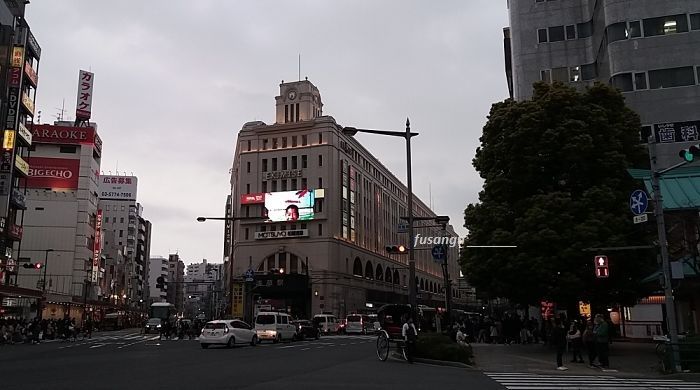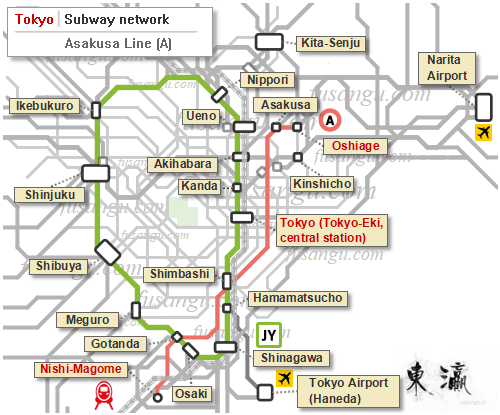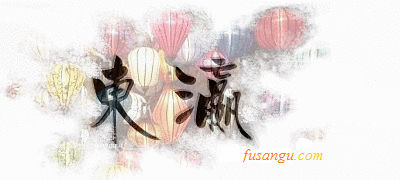

Among the vast network of subway lines that form the backbone of Tokyo’s mass transit system, the Asakusa Line plays a role of particular interest to those who visit the city for the purpose of tourism.
Furthermore, the Asakusa Line is used by through-service trains that link Haneda and Narita airports. Finding accommodation near one of the stations served by the Asakusa Line is certainly a strategic choice.
In this page we describe a one-day tour in eastern Tokyo. All transfers can happen by making exclusive use of the Asakusa Line.
The Asakusa Line (Asakusa-sen) is part of Tokyo subway network managed by Toei. The line crosses the eastern part of the centre of Tokyo along a north-south direction.
The termini are the following stations:
-
Oshiage, northern terminus; connection with the Hanzomon Line (Tokyo Metro’s subway network) and Keisei-Oshiage Line (part of the Keisei railway network). The station is served by trains that connect Narita Airport to Ueno and Asakusa;
-
Nishi-Magome, southern terminus, in Ota District.
The line serves areas of great interest to tourists such as the following:
-
Asakusa, historic neighbourhood situated north of Tokyo’s city centre;
-
Nihombashi and Ginza, in Chuo District, centre of Tokyo;
-
Takanawa, an upscale residential area in Minato District. Here are a few historic temples and museums.
From Nishimagome Station you can access Ota, the city’s southernmost district, where numerous parks, temples and onsen can be found.
Recommended itinerary along the Asakusa Line
An interesting itinerary can move from Oshiage Station, in Sumida District:
-
9:00 - 11:00: visit to Tokyo Sky Tree (Tokyo Sukai Tsuri), a large communication tower that offers unrivalled views over the metropolis and the wider region of Kanto. Nearby not to be missed out on is Japan Postal Museum;
-
11:15 - 13:45: visit to Asakusa. A short-walk from Asakusa Station and you can reach Senso-Ji, one of Tokyo’s most popular Buddhist temples. Along Nakamise-dori, the approaching path, are many tourist shops where you can find good-quality presents. In spring you may want to add a short walk through Sumida Park. Located near the eastern shore of Sumida River, the park is noted for the copious presence of cherry trees, many of which belong to rare varieties and whose flowering is most ornamental;
-
13:45 - 14:00: quick lunch;
-
14:30 - 17:00: visit to Takanawa, an affluent neighbourhood within Minato District. A must-see destination is Sengaku-Ji, ancient Buddhist temple, most famous for its connection to the vicissitudes of the forty-seven ronin. Not far are Hatakeyama Fine Arts Museum and Kakurin-Ji Temple.
Variants
Aside from including a visit to the centre of Tokyo (Marunouchi and Ginza), you can opt for additional destinations. Among the most interesting the following:
-
Ota: a large district located south of the city centre. South of Nishimagome Station is Ikegami Honmon-Ji, a large Buddhist temple. Nearby is a peaceful garden full of plum trees. Ota is very famous for the presence of onsen, thermal baths, many of which enjoy a solid reputation;
-
Meguro: the area around Gotanda Station offers a few temples and shrines as well as gardens. It can be included in a walking tour towards Nakameguro area, one of Tokyo’s best cherry blossom viewing spots.
Related articles:
Main article: Tokyo 3-day itinerary
Itineraries along the subway lines (Asakusa, Hibiya, Ginza, Marunouchi, Tozai, Mita, Namboku, Yurakucho, Chiyoda, Shinjuku, Hanzomon, Oedo, Fukutoshin)

